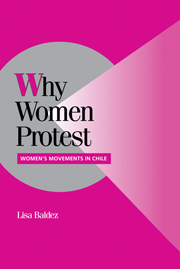Book contents
- Frontmatter
- Contents
- List of Figures and Tables
- Preface
- 1 WHY WOMEN PROTEST: TIPPING, TIMING, AND FRAMING
- 2 MOTHERS OF THE COLD WAR, DAUGHTERS OF THE REVOLUTION: A HISTORICAL OVERVIEW OF WOMEN AND CHILEAN POLITICS
- Part One Women Against Allende
- 3 THE REVOLUTION HITS HOME: WOMEN ORGANIZE AGAINST ALLENDE
- 4 CATAPULTING MEN TO ACTION: THE MARCH OF THE EMPTY POTS
- 5 “FEMININE POWER” AND THE END OF THE SOCIALIST REVOLUTION
- Part Two Women Against Pinochet
- References
- Index
3 - THE REVOLUTION HITS HOME: WOMEN ORGANIZE AGAINST ALLENDE
Published online by Cambridge University Press: 06 July 2010
- Frontmatter
- Contents
- List of Figures and Tables
- Preface
- 1 WHY WOMEN PROTEST: TIPPING, TIMING, AND FRAMING
- 2 MOTHERS OF THE COLD WAR, DAUGHTERS OF THE REVOLUTION: A HISTORICAL OVERVIEW OF WOMEN AND CHILEAN POLITICS
- Part One Women Against Allende
- 3 THE REVOLUTION HITS HOME: WOMEN ORGANIZE AGAINST ALLENDE
- 4 CATAPULTING MEN TO ACTION: THE MARCH OF THE EMPTY POTS
- 5 “FEMININE POWER” AND THE END OF THE SOCIALIST REVOLUTION
- Part Two Women Against Pinochet
- References
- Index
Summary
The status of women in Chile during the 1960s resembled that of women around the world in terms of the degree to which women became involved in politics. But in 1970, women's activism in Chile diverged dramatically from what was happening elsewhere. Women began to mobilize in Chile that year, but not along feminist lines. In Chile, conservative women mobilized on the basis of their gender identity well before their counterparts on the Left. Immediately after Salvador Allende won the presidential election in 1970, a small group of women from conservative political parties organized a series of protests aimed at mobilizing female opposition to Allende. They believed that Allende's victory had precipitated the formation of an alliance among the opposition parties and saw the moment as a propitious one for women's mobilization. However, their perceptions about the possibility of a realignment among the parties proved to be wrong. As a result, their efforts failed to ignite popular support and had little political impact.
While the opposition parties did not form a unified coalition against Allende during this initial period, their positions gradually converged over the course of Allende's first year in office. The centrist Christian Democrats and the right-wing National Party moved closer together, largely in reaction to the new government's success in implementing socialist reforms and consolidating popular support. Opposition groups began to mobilize in response to changing conditions and increasing threats from the Allende regime.
- Type
- Chapter
- Information
- Why Women ProtestWomen's Movements in Chile, pp. 49 - 75Publisher: Cambridge University PressPrint publication year: 2002



